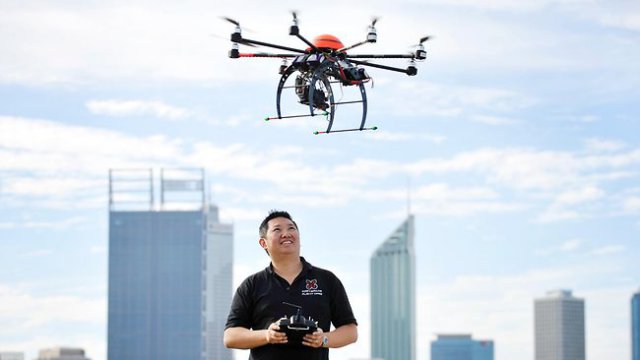Two Australian companies, Soto Consulting Engineers and aerial photography specialist Coptercam have come together to offer a faster and safer method for plant inspections using drones.
Coptercam is providing its drone expertise to Soto Consulting Engineers to conduct inspections and audits for the mining industry in dangerous and inaccessible areas.
Using Coptercam’s remote control flying equipment, commonly known as drones, Soto Consulting Engineers is able to eliminate reliance on teams of personnel, rigging and scaffolding and the associated dangers, while saving a significant amount of time compared to conventional inspection methods.
The drone alternative puts more control in the hands of proprietors through major cost savings and the near-elimination of shutdowns for plant audits.
Managing Director of Soto Group, Mr Frank Soto explains that heavy industrial and mining environments are harsh on both the service personnel and equipment, and the downtime associated with work can be a very expensive exercise. Additionally, safety of the people involved in the inspection is always at some sort of risk as inspection procedures normally involve an element of physical danger. With conventional methods, the overall condition of structures on some sites is perpetually overlooked because access is difficult, dangerous and expensive for operators and auditors.
Soto Consulting Engineers’ association with Coptercam opens up many new possibilities across a range of industries including civil engineering, mining, bulk handling, forensic engineering as well as the manufacturing and minerals processing sectors.
Requiring the involvement of just a few people, the drone solution available through Soto/Coptercam can achieve in a single day what traditional means would in a week. Instead of assembling a team of professionals with harnesses, scaffolding and other structures, a Coptercam craft is simply flown into the affected areas with a specially mounted camera capable of high resolution photo stills and video or thermal imaging.
The drone is operated remotely at a safe base on the ground by a fully certified Coptercam pilot and a camera operator alongside a Soto engineer viewing a HD monitor in real time during the inspection exercise. Using the HD live camera feed to the ground, the attending Soto engineer can direct Coptercam to focus on a specific area of interest when a hazard is identified.
The camera is mounted on a 3-axis gyro-stabilised gimbal that is controlled independently of the aircraft in both 360-degree pan rotation and 110 degrees of tilt with remote record control and shutter control.
Coptercam technology has been used to inspect diverse structures including bridges, exhaust stacks, roads, elevated conveyors and handling towers among many others. The drone camera inspection method doesn’t require the site to shut down; the usual week-long inspection process can now be completed in a single day.
According to Mr Soto, statutory structural audits in the coal mining industry will be one of the real beneficiaries of the new inspection solution; these audits are required to be undertaken annually to locate potential hazards arising through vibration, stress fatigue or corrosion. However, difficult access and terrain restrict the inspection of many structures, resulting in the true condition of the structure or plant remaining unseen and unreported possibly for years, thus giving rise to hazardous issues.
Coptercam’s Mr Glen McGarry says traditional methods of site inspection at a mine site, exhaust stack, bulk handling facility or high rise structure always involve a rather large team of people, a lot of OH&S induction and familiarisation, and considerable time to complete. The use of drones completely minimises the physical risk that these people and contractors are exposed to, especially at heights or in confined spaces.
Coptercam is fully licensed and authorised by the Civil Aviation Safety Authority (CASA) for provision of all its services.
The company has offices in Perth, Sydney, Melbourne, South Australia and a satellite office in Brisbane. The ACT is serviced by Sydney and NT by South Australia.
A drone can be mounted with a camera of choice (24MP with real-time zoom function or 36MP fixed), positioned to hover in the air at any chosen viewing point, and take as many photographs as required for Soto engineers to analyse back at the office. The team can then easily work out the remediation plans without sending a single human being into the danger zone.
Source: infolink

